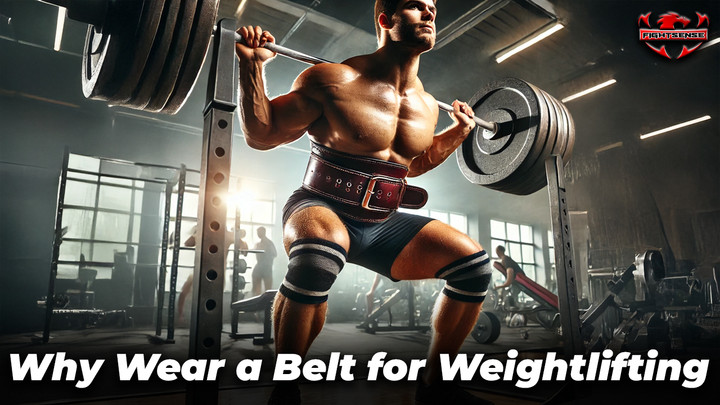Why Wear a Belt for Weightlifting? Benefits & Myths
18th Mar 2025
Why wear a belt for weightlifting? Although commonly seen in gyms, weightlifting belts are neither just a trend nor a mandatory tool. When used correctly, they enhance performance by improving core stability, reducing spinal strain, and lowering the risk of injury.
They also promote proper posture and help minimize lower back stress, though many myths still surround their effectiveness.
In this guide, we’ll cover the key advantages, their role in injury prevention, different types of weightlifting belts, who should consider using them, and research-backed insights into their true benefits.
Key Highlights
-
Why wear a belt for weightlifting? The purpose of wearing a belt is to enhance core stability and prevent injuries.
-
Why wear a lifting belt? It improves form and reduces spinal stress.
-
Why wear a belt when lifting? It allows better force distribution and stability.
-
Why wear a weightlifting belt? The purpose of the belt is to safely support heavy lifts.
-
Use a belt correctly for maximum benefits without over-reliance.
Why should weightlifters wear belts?
Not only a tool a weightlifting belt is also critical for injury prevention, spinal support, and core stability. This page explains why it's important.
1. Strengthens core stability
We advise weightlifting belt wear primarily to create intra-abdominal pressure (IAP). The belt serves as an external force, allowing your core muscles to push against it, therefore stabilizing your spine and lowering tension on your lower back.
2. Stovers Lower Back Injuries
Your lower back is in danger with big exercises like deadlifts and squats. Why, while lifting, wear a belt? It prevents too much spinal flexion or extension since it equally distributes pressure over your core.
3. Enhances lifting performance.
Many lifters question why, with their powerful core muscles, they need to use a lifting belt. Wearing a belt helps you securely raise greater weights by providing a strong basis for force development and enhancing strength output.
4. Releases Stress on the Spine
The belt serves as a barrier of protection, therefore lessening spinal compression. Those who regularly heavy lift—powerlifters and bodybuilders especially—will find this function especially helpful.
Weightlifting Belt Types
Not all belts are made equally; therefore, selecting the correct kind will greatly affect performance and safety.
-
Weightlifting Belt
-
Lever Belt
-
Velcro Belt
-
Tapered Belt
-
Straight Belt
-
Dipping Belt
-
Bodybuilding Belt
Who Should Do a Weightlifting Belt?
One often-asked issue is whether novice lifters should wear a belt or if it is just for advanced lifters. Actually, a belt serves both purposes.
-
Beginners: Under big loads specifically, beginners help to establish correct lifting techniques.
-
Advanced lifters: Give extra core support during maximum effort lifts.
-
Casual gym-goers: Useful for everyone doing compound motions, including deadlifts, squats, and overhead presses, casual gym-goers.
Why Use a Lifting Press?
1. starts with squats and deadlifts.
-
It facilitates a neutral spine posture.
-
It reduces lower back shear strain.
-
Aids improved form and technique.
2. Jerk and overhead press and clean
-
Increasing central involvement in aerial motions is beneficial.
-
This aids in maintaining balance and reduces excessive spinal arching.
Scientific Research on Belt Efficiency
Studies confirm the advantagesof wearing a weightlifting belt Some important discoveries consist of:
-
Weightlifting belts have been found to raise intra-abdominal pressure (IAP) by up to 40%, therefore lowering spinal strain.
-
Research shows that belt-wearing lifters can raise anywhere between 5 and 15% more weight than those without a belt.
-
Sports science studies indicate that belts increase lumbar support, therefore lowering the likelihood of lower back problems.
Common Stories About Donning a Weightlifting Belt
1. A belt compromises your core
Some say wearing a belt causes core muscles to become sluggish. Actually, belts raise intra-abdominal pressure, so improving core activity.
2. Belts for Powerlifters Only
False, not accurate Improved stability and safety help even casual gym-goers execute complex exercises.
3. You should don a belt for every workout.
There is no need for wearing a belt for solitary exercises such as bicep curls. It's especially useful during compound lifts when spinal support is very vital.
How Should One Select a Weightlifting Belt?
Maximizing advantages depends on choosing the correct belt. The following are important considerations:
-
Size: Make sure the fit is tight yet pleasant.
-
Material: Leather for stability and longevity; nylon for flexibility.
-
Thickness: General use calls for 10 of thickness; heavy powerlifting calls for 13.
-
Closure Type: Lever belts give a safe fit; prong belts let you adjust.
How to Make Correct Use of a Weightlifting Belt
To maximize benefits, follow these steps:
-
Position the Belt Correctly: Place it around your lower back and abs.
-
Tighten Without Restricting Breathing: You should feel pressure but still be able to breathe properly.
-
Brace Your Core Before Lifting: Push your abs against the belt for maximum stability.
Shop Now !
Conclusion
Now you understand why wear a belt for weightlifting—it’s not only for professional athletes but also for anyone aiming to boost stability, prevent injuries, and lift heavier with confidence. Whether you’re asking why you should wear a lifting belt or why you should wear a belt when lifting, the answer is simple: it’s a game-changer for strength training.
Disclaimer:
This article is for informational purposes only. Always consult a certified fitness professional or healthcare provider before making any changes to your lifting routine.

